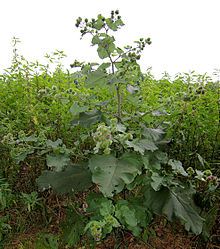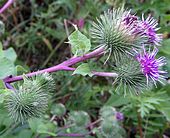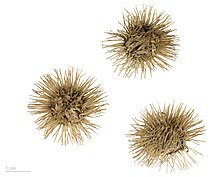
Native to temperate regions of Europe and Asia, this herbaceous biennial is a member of the aster family, Asteraceae, that also includes daisy, yarrow, and lettuce. The plants produce a rosette of leaves the first year and then in the second year grow up to 10′ tall and have a fleshy, gray-brown taproot up to 3′ long, and a green, straight smooth stem bearing large heart-shaped leaves up to 6″ long with long petioles and woolly undersides. In mid-summer purple disc flowers appear in globular, flat flowerheads. Each flowerhead is 1 to 1.5″ wide and is surrounded by an involucre of bracts that are curved to form hooks. The hooks of mature flowerheads catch on the fur of mammals and are carried to nearby areas. The fruit is a one seeded achene with a pappus of short hairs that further aid in seed dispersal and are very irritating to the eyes and mucous membranes. Greater burdock is valued as a vegetable and for its use in medicine, but can become an invasive weed that is very difficult to eradicate because of its deep taproot and abundant production of seeds. Other common names include bardane, beggar’s buttons, snake’s rhubarb, gobo, and thorny burr. The genus name, Arctium, is from the ancient Greek word arction, the name of a plant, perhaps a mullein. The specific epithet, lappa, is the Latin word meaning burr and refers to the dried flowerhead. Photo Credit Wikipedia

Type: Herbaceous biennial
Bloom: Heads of purple flowers in mid-summer
Size:10′ H
Light: Full sun
Soil: Nitrogen rich, humusy, consistently moist, well-drained

Hardiness: Zones 3-10
Care: Control spread by removing flowers before seed set.
Pests and Diseases: Generally healthy but susceptible to powdery mildew and root rot
Propagation: Seed
Companion Plants: Other root crops such as horseradish, onion, potato
Outstanding Selections: None available
Photo Credits: Wikipedia